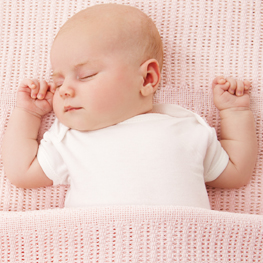
There’s nothing more beautiful and peaceful than a sleeping baby, and babies spend a lot of their time sleeping. That’s why it’s important to follow safe sleep practices to help lower the risk of Sudden Infant Death Syndrome (SIDS) and other sleep-related injuries and deaths in your baby’s first year.
What are safe sleep practices?
Research has shown that the risk of SIDS and other sleep-related injuries and deaths may be reduced by taking these steps:
Put your baby on their back to sleep, for every sleep. Whether it’s naptime or nighttime, a baby placed on their back to sleep has a lower risk of SIDS.
Choose a safe place for your baby to sleep. The safest place for your baby to sleep is a firm, flat, uncluttered surface. Use a crib, cradle, or bassinet that meets current Canadian government safety standards and is put together and used according to the manufacturer’s instructions.
Keep your baby warm, not hot. Babies are safest when the room temperature is comfortable for adults wearing light clothing. Overheating (when babies are too warm) increases the risk of SIDS. If the room is cool, choose a warmer sleeper for your baby. If you’re using a blanket, make sure it’s lightweight, firmly tucked under all three sides of the mattress, and reaches only to your baby’s chest. Keep your baby’s head uncovered and avoid using hats when they’re indoors.
Keep spaces smoke-free before and after birth. Babies whose mothers smoke during pregnancy are at much greater risk of SIDS. Make sure no one smokes around your baby, at home, during travel, or while being cared for. Exposure to second-hand smoke both before and after birth also increases the risk of SIDS.
Breastfeed your baby for good health. Breastfeeding can protect your baby from the risk of SIDS and other illnesses. The Canadian Paediatric Society, Public Health Agency of Canada, and Alberta Health Services recommend only breastfeeding your baby for the first six months of life.
Share a room, not a bed, with your baby, for the first six months. Room-sharing means that your baby sleeps in the same room as you, but on a separate sleep surface (e.g., crib, cradle, or bassinet). Room-sharing keeps your baby close and helps keep your baby safe. It also makes it easier to feed your baby, especially at night. Babies brought into bed for feeding are safer when put back into their crib, cradle, or bassinet to sleep before you go to sleep. They are safest sleeping in their own crib, cradle, or bassinet.
Bed-sharing means that a baby is sleeping on the same surface with another person (e.g., mom, dad, another child) or pet. Bed-sharing can increase a baby’s risk of injury and death, including SIDS. Babies can fall, be strangled, or suffocate if they get trapped in cracks or under bedding, pillows, cushions, or a person. Bed-sharing is not recommended by the Canadian Paediatric Society, Public Health Agency of Canada, and Alberta Health Services.
Following these steps will help you to create a safe sleep environment for your baby. If you have questions or concerns about safe sleep for your baby, talk with your health care provider or call Health Link at 811.
This information contains excerpts from Alberta Health Services’ Safe Infant Sleep resources. For more information on safe infant sleep or topics related to pregnancy and being a parent, and for more information on where you can pick up free print copies of the Healthy Parents, Healthy Children resources, visit healthyparentshealthy children.ca.
The Healthy Parents, Healthy Children team is a part of the larger Healthy Children and Families’ team at Alberta Health Services. Find them on Facebook at Healthy Parents, Healthy Children or follow on Twitter @AHS_HPHC. For questions or comments, contact This email address is being protected from spambots. You need JavaScript enabled to view it..
Calgary’s Child Magazine © 2024 Calgary’s Child